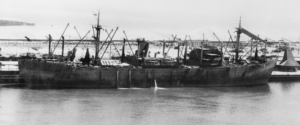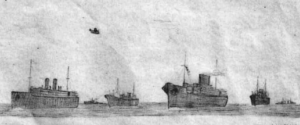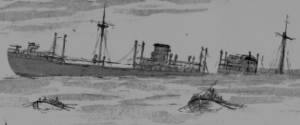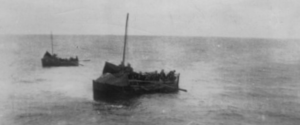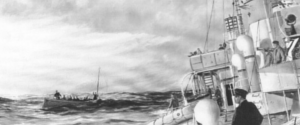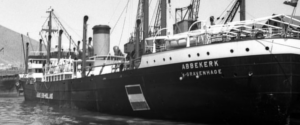Abbekerk’s aftermath : the sailors

 Adriaan Willlem Kik (Engineer)
Adriaan Willlem Kik (Engineer)
After his ‘torpedo’ leave he sailed a few voyages on the Shell tanker Macuba en the rest of the war on board the SS Maaskerk (VNS). The ‘lucky’ Maaskerk sailed up and down from England to the Caribbean for the whole duration of the war and did so without as much as a scratch.
On 5th May 1945 it was all over. It had been more than enough!
It was not until March 1946 that I returned on the ‘Maaskerk’ to the Netherlands where I had left on 2nd February 1940 with the ‘Abbekerk’, for just one voyage, so I read in my seafarer’s papers.
In the end it took six years to come back home.
Engineer Adriaan Kik
After the war he stayed on as engineer at the VNS on merchant ships till he married in the late 50’s and became Chief Engineer at the Provincial Steamboat Services (Provinciale StoombootDiensten – PSD) in the province of Zeeland, Netherlands. There he sailed on ferries up and down the river Schelde, the same river where he boarded the Abbekerk in Antwerp in February 02, 1940, for the voyage that would take six years.
In the marriage three children were born among whom his son Peter, who manages this website. In 1998 he started to write down his memoirs of his sailing days during the war. He had almost finished them as he died in 2000, age 80.
He could not have foreseen that his story about Abbekerk and her crew can now be read worldwide.
Walter MacNab (DEMS gunner)
 For Walter the story was not over after the rescue. If you’ve read the whole story of the Last Voyage you may remember that he received a letter in the Dutch East Indies from a soldier who was leaving the ship to embark on the impossible task to stop the Japanese onslaught. He had put the letter in his ‘kitbag’ together with other important papers, photographs and his new pair of handmade shoes bought in Durban. As they were torpedoed, on his way to the bridge he had already thrown his kitbag in a lifeboat and never saw it again. He was quite upset by that mainly because of the letter.
For Walter the story was not over after the rescue. If you’ve read the whole story of the Last Voyage you may remember that he received a letter in the Dutch East Indies from a soldier who was leaving the ship to embark on the impossible task to stop the Japanese onslaught. He had put the letter in his ‘kitbag’ together with other important papers, photographs and his new pair of handmade shoes bought in Durban. As they were torpedoed, on his way to the bridge he had already thrown his kitbag in a lifeboat and never saw it again. He was quite upset by that mainly because of the letter.
As he came back to shore in England he visited a pub and to his perplexity saw someone walking in his new shoes…. It turned out to be a crew member from one of the destroyers who found the kitbag after everyone had already left the ship and had not been able to find the owner. And who had taken a shine to the new shoes.
So Walter was finally able to post the letter.
After that it still was not over. A month after posting the letter he received a visit from the military intelligence. They wanted to know how he came to be in possession of the letter. It turned out that no one from the soldier’s whole regiment had come back from the Dutch East Indies and nobody knew what happened to them. The letter (and the location where it was given to Walter) was the last anyone ever heard of them.
After the sinking of Abbekerk he remained DEMS gunner and sailed on a number of ships, mostly coasters. After the war he stayed in the military and was deployed to North-East Africa.
Walter died in 2015, 91 years of age.

The VNS ship Boschfontein server as a troopship during the Pacific war. Here seen just after the war but like most ships still carrying extra wartime floats due to the hazards of mines.
Jacob Visser (Third Mate)
After his ‘torpedo’ leave he went to San Francisco to work in the offices of VNS which main occupation was the management of the ‘fontein’ ships the VNS had in the Pacific. These ships – often as troopships – supported the island invasions of the US. Like with most merchant seamen his war didn’t end with the defeat of Germany but only after Japan surrendered in September 1945.
After the war he remained a sailor.
Geoff North (Lieutenant, 35th LAA, temporary gunner on Abbekerk)
 Together with his 11 colleagues he was ordered off Abbekerk in Oosthaven, Sumatra with the Bofors AA guns to help stop the Japanese invasion. The invasion proved to be unstoppable and it looked more like a suicide mission. Geoff was captured on Java. For most of the war he was held prisoner in the infamous Kuching prisoner of war camp on Borneo. He was the driving force behind ‘the garden’, a scheme where prisoners grew their own food and which saved many lives. More on Geoff’s story can be read here.
Together with his 11 colleagues he was ordered off Abbekerk in Oosthaven, Sumatra with the Bofors AA guns to help stop the Japanese invasion. The invasion proved to be unstoppable and it looked more like a suicide mission. Geoff was captured on Java. For most of the war he was held prisoner in the infamous Kuching prisoner of war camp on Borneo. He was the driving force behind ‘the garden’, a scheme where prisoners grew their own food and which saved many lives. More on Geoff’s story can be read here.
His health had been terribly affected by the years in the prison camp and therefore he had to leave the military. He started a succesfull frozen foods company.
Geoff died in 1991. 82 years of age.
Bernard Finn (Steward)
Bernard Finn, who lied about his age to go sailing, remained a sailor during war and did so for the rest of his life. He was not torpedoed a third time.

